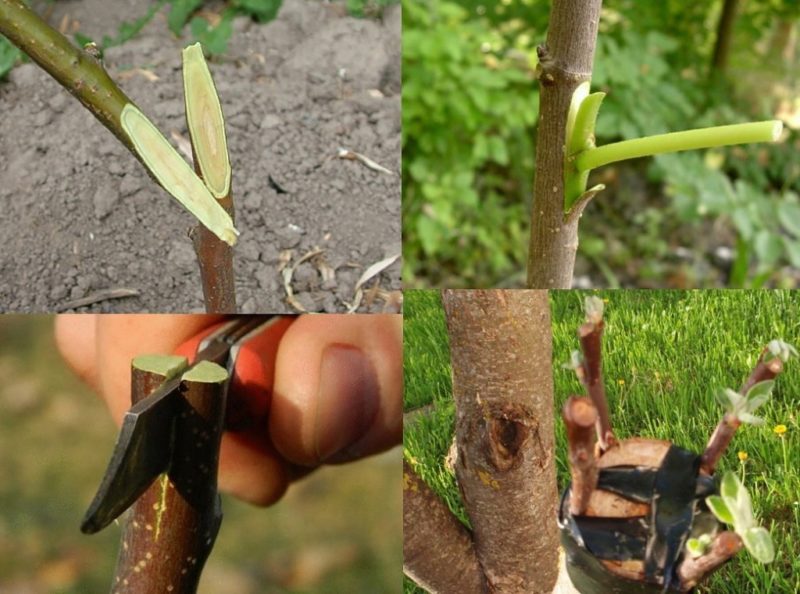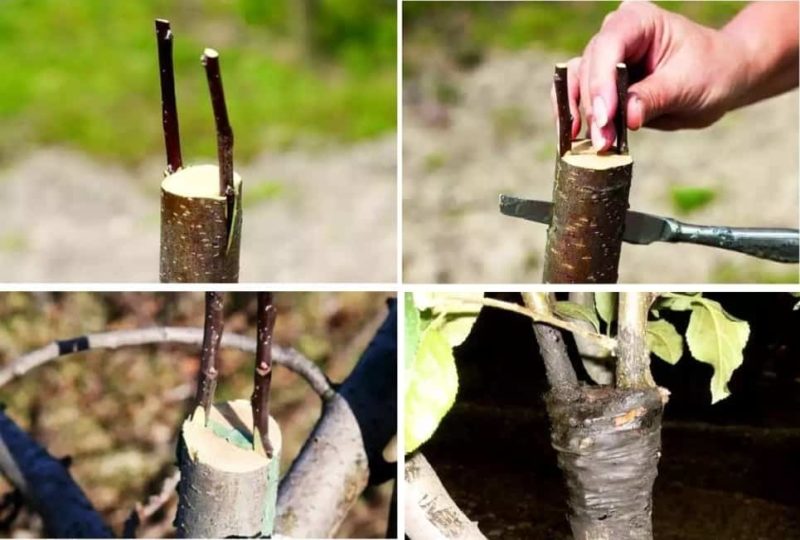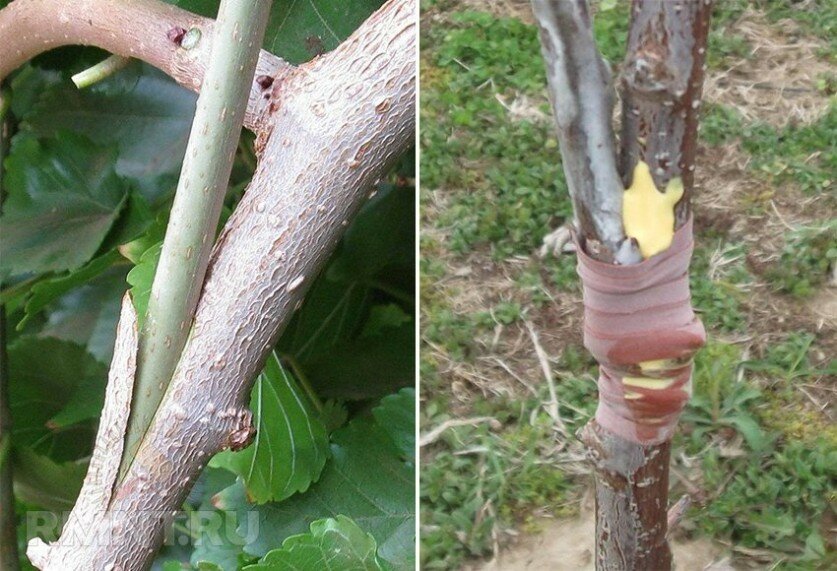Instruction for gardeners: grafting an apple tree in summer with fresh branches in stages in different ways
The apple tree is one of the most unpretentious fruit and berry plants. It has a long lifespan and bears fruit abundantly for several decades. Apple cuttings are easily grafted onto different trees and quickly begin to bear fruit.
Vaccination work can be carried out from early spring to late autumn. Many gardeners prefer to do this in the summer. Summer grafting of fruit trees has many advantages and is characterized by high survival rate.
The content of the article
Why plant an apple tree in the summer with fresh branches

The apple tree does not need to be grafted. This hardy culture can grow in almost all regions of our country.
She is not afraid of winter frosts, spring frosts, temperature changes, prolonged precipitation and the scorching sun. Bears fruit for a long time, reproduces well cuttings.
Despite the plant's hardiness, many gardeners graft apple trees.
This procedure has the following goals:
- Increased endurance... Grafting makes it possible to grow non-zoned varieties, for example, heat-loving plants in the central region. A correctly chosen stock increases resistance to negative environmental factors, the immunity of the scion.
- Saving space on the site... If the garden is not large enough, but you want to grow several varieties of apple trees, several different branches can be grafted onto one plant.
- Aesthetics... Different varieties and even crops can be grafted onto one tree. At the same time, apples of different colors will grow on one plant, at the same time rowan and apples, pears and apples, etc. Such a neighborhood looks very unusual.
- Saving time. The grafted branch begins to bear fruit 2 times faster than a self-rooted plant propagated in a vegetative or generative way.
- Renewal of old trees. Rather than uprooting old, poorly fruiting trees, experienced gardeners recommend trim them and graft new branches to them.
- The opportunity to practice. Apple grafts take root much better than many other fruit and berry plants. At the same time, many cultures really need a mandatory vaccination. Therefore, beginner gardeners are advised to practice on apple trees before moving on to more capricious plants.
Benefits of Summer Vaccination
Many gardeners prefer to vaccinate their apple trees with fresh branches in the summer.
Carrying out the procedure during this period has several advantages:
- Speed. With summer grafting, a new branch takes root, starts growing and begins to bear fruit a year earlier than with the autumn one. Already in the fall, we will be able to make sure of the positive result of the work done.
- No need for preliminary preparation of grafting material... To plant an apple tree in spring, cuttings are carried out in the fall. In summer, the tree is grafted with freshly cut cuttings.
- An opportunity to verify the quality of the grafting material. In the spring, a novice gardener may not distinguish branches frozen in winter, and by summer, poor-quality grafting material dies off on its own.
- High chances of success. In the summer, new cells are actively formed, and the parts grafted to each other firmly grow together. Summer vaccinations do not need constant and careful care.
- Using everything cut planting material... Some of the cuttings that were harvested in the fall do not survive until spring. In the case of summer grafting, all rootstocks are used.
- A neat place of tissue fusion... With summer grafting, large sagging does not form at the junction of the scion with the stock, due to which the combination ring is practically invisible.
Summer grafting is also practiced if spring work has not brought positive results.
Dates of the procedure in summer
The timing of summer grafting of fruit trees depends on the climate of a particular region and the weather.
The work must be completed no later than 2 weeks before the temperature drops below + 15 ° C.
Vaccination work is recommended to be carried out in the second half of summer, when annual shoots have already stopped active growth. June is not a good time, since during this period active tissue growth is still ongoing, and pruning harms the tree. In the northern regions, return frosts are possible at the beginning of summer.
The optimal time for the vaccination procedure is the second half of summer.
When choosing the timing, it is important to take into account the specific climate of a particular region:
- Northern (Ural, Siberia)... The procedure is carried out from July 12 to August 5. The best grafts take root from 12 to 25 July.
- Central regions (Kaliningrad, Moscow, Kaluga, Leningrad regions). The vaccination is done from mid-July to mid-August.
- Southern. The best results are achieved by planting an apple tree in the first half of August, but the procedure can be continued from mid-July to the end of August.
Preparation of rootstock and branches
For the graft to take root, it is important to choose the right graft and stock.
It is the low-quality grafting material that causes the negative results of the work performed.
Graft
As a scion, apple trees are chosen that have been actively growing and bearing fruit during the past years, and have not been sick with viral infections. It is important to make sure that there are no signs of disease and plant pests.
To select a suitable branch, you need to pay attention to the following signs:
- Kidneys. Unripe shoots are not suitable for grafting. The apical bud must be fully formed. Another sign of maturity is an increase in the distance between internodes at the top of the branch.
- Bark condition. A shallow incision is made on the bark of the selected shoot. They pry it off with a fingernail and try to separate it from the wood. If the bark comes off easily, then the shoot is ripe.
- Growth and flower buds. For vaccination, choose a part on which there are more growth buds - flattened and elongated. Flowering specimens are more round and voluminous.
- The location of the branches. The shoots inside the crown will not work, since flower buds predominate on them, and they are weak due to shading. The branches outside the crown are covered with growth buds and are considered ideal for grafting.
- Appearance. For inoculation, take already lignified, but still green shoots of the current year. They should be smooth to the touch, without distortions or flaws.
- The size. The length of the rootstocks is at least 30 cm, and the diameter is 5-6 cm. There must be at least 4 buds on the handle.
Green cuttings are cut in the morning from 4 to 10 hours on the day of grafting. During this time, the sun is not active, the trees will not get burned and experience less stress. The day before grafting, the mother plant is abundant watered.
If the cuttings are grafted within 2-3 hours after cutting, there is no need to put them in water. If it takes more time to prepare, the grafting material is placed in a bucket of water or wrapped in a damp cloth.
Before use, all leaves are cut off from the cuttings, leaving petioles up to 10 mm long. The stipules also need to be removed.
Note!The ripening time of the stock and the scion must coincide.
Rootstock
When choosing a stock for an apple tree, it is important to pay attention to crop compatibility. The cultivars of apple trees and wild birds, grown with their own hands from seeds or dug up in the forest, are best suited.
You can graft the apple tree on other crops. Among them:
- Rowan. On black chokeberry, apple branches take root worse than on red. When an apple tree is adjacent to a mountain ash, the fruits will shrink.
- Pear. It takes root much better as a scion, but apple branches do not always take root on it.
- Quince. The chances that apple branches will take root on quince are low. Often the fruits on such branches become smaller.
- Viburnum and hawthorn... The apple tree takes root well on such rootstocks, but its fruits shrink.
It is best to grow an apple tree onto an apple tree. In this case, the variety will acquire frost resistance, and the quality of the fruit will not deteriorate. These are the strongest vaccinations.
The tree that will become the stock must be checked for signs of diseases and pests. For these purposes, zoned varieties are chosen.
It is advisable to choose not the oldest trees. For summer grafting in spring cut off all dry and extra branches so that the plant spends its energy not on them, but on the scion.
How to properly plant an apple tree with a fresh branch

For grafting apple trees in the summer, fresh branches of the current year are used. For the procedure to be successful, you need to prepare tools and materials, and also choose the appropriate method.
Required materials and tools
A number of instruments must be prepared for vaccination. Among them:
- Hacksaw. For cutting branches on the stock.
- Pruner. For harvesting cuttings.
- A scalpel or a sharp garden knife. They are given the desired shape to the ends of the shoots.
- Electrical tape, garden or plumbing tape. Used for strapping.
- Film.
- Garden var.
Before planting an apple tree in July, you need to make sure that the tool is well sharpened and that the hacksaw is in good working order and does not have broken or bent teeth. A poor-quality tool makes the sections uneven, which reduces the tightness of the rootstock and scion sections, reducing the likelihood of tissue fusion.
It is interesting! Some gardeners use a drill to make a hole for the rootstock on the scion.
Procedure guide
There are many ways to get vaccinated. Each of them has its own subtleties and technology.
Into the cleft
Splitting technology is considered by many gardeners to be the easiest method of grafting. In this case, it is easy to make cuts in the scion and rootstock that coincide with each other.
Step-by-step instructions for cleavage vaccination:
- Choose a tree 3-6 years old, which will become the stock. In the split, they are grafted into a stem or into a skeletal branch. The selected area is cut by at least a third, removing excess shoots.
- A split 3-6 cm deep is made in the center of the scion. It should be slightly deeper than the length of the wedge on the rootstock.
- The lower end of the rootstock is sharpened on both sides with a flat wedge 3-5 cm long.
- A scion wedge is inserted into the rootstock split so that the bark and layers of elements coincide at least on one side. If the rootstock diameter is large, several grafts can be inserted into it.
- The place of the split on the scion is tightly wrapped with garden tape. In this case, the electrical tape should go from the scion to the stock.
- All cuts on the scion are covered with garden var.
For the bark
Bark grafting is another easy way to do the procedure.
To help novice gardeners, there is an instruction:
- The graft (it can be a bole or a thick skeletal branch) is cut at least in half. From the place of the saw cut down the bark, a longitudinal cut with a length of at least 3 cm is made. The bark is lifted with a fingernail and raised.
- A flat wedge is made at the bottom of the scion. Its length will be slightly less than the cut on the rootstock bark. Some gardeners cut the wood at the bottom so that on one side there is a protruding thin section with bark.
- The scion wedge is inserted under the bark, covering it with cut flaps.
- The junction is tightly tied with electrical tape. The cuts are covered with garden pitch.
Budding
When budding, a kidney with a part of the bark is used. This method is difficult to implement, but gives good results. Many gardeners prefer to use it.
Step-by-step instructions for budding:
- The graft bud is cut from the central part of the shoot together with a flat area of bark and wood 1.5-2 cm long. The leaves are removed from it together with the petiole.
- A T-shaped incision is made on the rootstock bark. The chances of survival will increase if a site with a kidney is chosen for these purposes.
- The bark leaves on the rootstock are pushed apart. A graft bud is inserted into the resulting pocket.
- The bark leaves are pushed in. The junction is wrapped with electrical tape so that only the kidney remains open.
By the bridge
This method is suitable for trees with damaged bark.
For healthy plants, it is usually not used:
- On the scion at the site of bark damage, 2 annular cuts are made. The section of the bark between them is removed.
- Wipe the exposed area with a clean napkin. Longitudinal sections are made from above and below on the bark; the top and bottom should be opposite each other. The number of slices should be equal to the number of grafted cuttings.
- The cuttings are sharpened with a flat wedge from the upper and lower ends.
- The lower end of the scions is inserted into the lower cuts on the rootstock bark. When all the cuttings are inserted, the junction at the bottom is tightly wrapped with electrical tape.
- The cuttings are bent with a bridge and the upper wedge is inserted into the upper bark incisions on the rootstock. Make a winding.
- The bare area on the rootstock is covered with garden pitch.
Copulation
Copulation is the last popular grafting method that is used when the diameters of the scion and rootstock are the same.
The technology is simple:
- The rootstock and scion at the bottom are cut at an acute angle.
- The slices should be completely aligned and snug against each other.
- Make a winding. To increase the strength of the structure, you can insert a stick into the winding.
- The upper cut of the scion is covered with garden var.
Common mistakes to avoid

Novice gardeners often make mistakes that reduce the chances of successful grafting:
- Grafting to the edge of a branch or tree. In this case, the scion receives few nutrients and develops slowly. Graft the apple tree correctly to the base.
- Lack of intensive care after vaccination. The tree to which the apple tree was grafted needs increased care, frequent watering and dressing.
- Winding too tight. It pinches the tissues, disrupting the sap flow, and the stalk receives little nutrients. The winding should be tight, but not tight.
- Using polyethylene for wrapping. It creates a greenhouse effect that leads to tissue decay.
Post-vaccination care
It is important to look after the tree after grafting.
The basic rules of care are described below:
- All young shoots formed on the scion and next to the inoculation are removed. It pulls in most of the nutrients, reducing the chances of survival.
- It is important to keep birds away from the vaccine as they can break it.
- 3-4 weeks after the procedure, the winding is removed.
- 3 weeks after grafting, the tree is fed.
- The grafted apple tree is watered as the soil dries.
Tips on the topic
Here are some tips to help simplify the vaccination procedure:
- The electrical tape is attached to the junction of the tissues with a sticky layer outward so that when the winding is removed it does not damage the tissue. Instead of duct tape and garden tape, you can use a regular rag.
- In cold weather, var hardens, and when it gets on clothes, greasy stains that are difficult to wash remain. Whitewashing does not have such disadvantages, which can be replaced by a garden pitch.
- A grafting gun is used to make the same cuts. It facilitates the procedure.
Conclusion
The apple tree is one of the most unpretentious, hardy and easy-to-graft fruit trees.Its grafts easily take root in suitable rootstocks, rarely die off, therefore, it is recommended for novice gardeners to begin the grafting experiment with apple trees.
Despite the apparent complexity, the vaccine is easy to perform. The main thing is to choose the appropriate method and comply with the basic conditions.